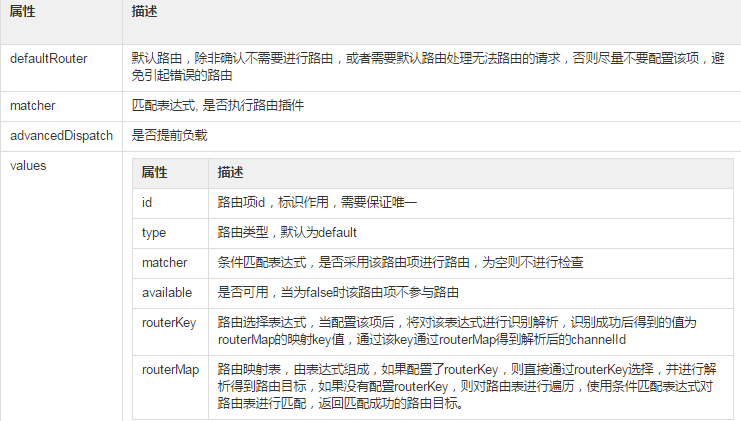路由配置
网关将接入的请求根据路由策略来指定该请求的转发地址

路由配置示例1:
defaultRouter: clientChannel1
defaultNameSpace:null
pipeType: null
#本地识别器
localRecognizers:
- id: recognizer1
keyMap: {channelId: '${channelId}'}
type: map
- id: recognizer2
keyMap: {pathToken: '${path}'}
type: url
values:
- available: true
id: router1
routerKey: ${channelId}
routerMap: {a: helloworldService, b: clientChannel}
- available: true
id: router2
matcher: '${pathToken}->*myapp*'
routerMap: {'${pathToken}->*.wsdl': wsdlService, '${pathToken}->*Service.json': helloworldService}
type: default
首先尝试通过router1进行路由,通过map识别器,识别channelId,识别后通过路由表进行静态映射,假设${channelId}=a,则选择helloworldService进行路由.
如果channelId识别失败,或者识别后查找不到匹配的映射项,则尝试使用router2进行路由,检查${pathToken}是否含有"myapp"字符串。如果含有,尝试使用该路由项进行路由,router2没有配置routerKey,则对路由表中的映射项进行条件匹配,如果以“.wsdl”结尾,则选择wsdlService进行路由,如果以“Service.json”结尾,则选择helloworldService进行路由。
| 当配置routerKey后,routerMap中的映射key应该是静态量或表达式,如果没有配置routerKey,则routerMap中的映射key应该是条件匹配表达式。 |
|---|
| 不论哪种方式,routerMap中的映射项value值都可以是静态常量或者表达式。 |
路由配置示例2:
#全局识别器
recognizer:
values:
- id: recognizer4
keyMap: {pathToken: '${path}'}
type: url
- id: recognizer3
keyMap: {all: '${all}'}
type: all
- id: recognizer2
keyMap: {host: '${host}', path: '${path[2..]}'}
type: url
- id: recognizer1
keyMap: {type: '${type}', busiId: '${head.busiId}', version: '${head.version}'}
type: map
available: true
pipeType: direct
inbound: true
#路由
router:
values:
#访问任意http://127.0.0.1:9000/*helloworld.json
- id: router1
routerMap: {'${pathToken}->*helloworld.json': jsonChannel, '${pathToken}<>*helloworld.json && ${pathToken}->*.json': jsonChannelDynamic}
available: true
matcher: '${pathToken}->*.json && ${localPort}->9000'
type: default
#访问任意http://127.0.0.1:9001/*/ws/*
- id: router2
routerMap: {'${pathToken}->*/ws/*': webserviceOutBoundChannel}
available: true
matcher: '${localPort}->9001 && ${pathToken}<>*wsdl'
type: default
#访问任意http://127.0.0.1:9001/*wsdl,路由到透传渠道,用来解析wsdl文件请求
- id: router3
routerMap: {'${pathToken}->*wsdl': httpTransparentChannel}
available: true
matcher: '${localPort}->9001 && ${pathToken}->*wsdl'
type: default
#所有通过9002端口接入的请求,全部路由到http透传渠道
- id: router4
routerMap: {'1->1': httpTransparentChannel}
available: true
matcher: '${localPort}->9002'
type: default
#所有通过9003端口接入的请求,全部路由到socket透传渠道
- id: router5
routerMap: {'1->1': socketTransparentChannel}
available: true
matcher: '${localPort}->9003'
type: default
#所有通过9004端口接入的请求,socket定长,内容为xml
- id: router6
routerMap: {'1->1': socketFixLengthXmlChannel}
available: true
matcher: '${localPort}->9004'
type: default
advancedDispatch: false
available: true
pipeType: direct
inbound: true
defaultRouter: httpTransparentChannel